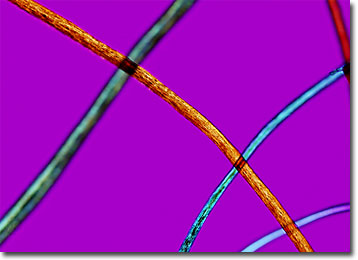Polarized Light Microscopy Digital Image Gallery
Yak Down
A yak is type of ox that can be found in the greatest numbers in Tibet, where it is sometimes referred to as the “treasure of the plateaus.” Massive in size, yaks may achieve a shoulder height of up to six feet and a weight that exceeds 2,000 pounds.

Yaks, which are scientifically described as Bos grunniens, are members of the bovine family, Bovidae. Their appearance is dominated by muscular, humped shoulders, sizable upcurved horns, and a long, shaggy outer coat of hair. In wild individuals, this coat as well as the soft, warm underfur, or wool, is usually dark brown to black in color. Domesticated yaks, however, are often piebald black and white due to their interbreeding with other domestic cattle, as well as smaller in size than their untamed counterparts.
Domesticated for hundreds of years in Tibet, yaks are extremely useful to humans, who utilize the bovines in a variety of ways. The hairy tails of the animals, for instance, are used as fly swatters in some parts of the world, and their hides are commonly utilized as leather. Yaks also frequently serve as beasts of burden, as well as sources of meat and milk. The most luxurious item that is derived from yaks, however, may be considered the unusually soft, warm wool of their undercoats that can be spun into a cashmere-like fiber used to fabricate sweaters, coats, and similar items.
